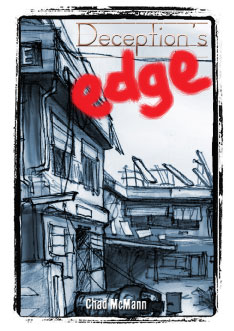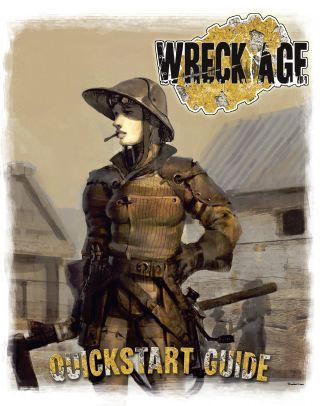 |
| The WIP Wreck-Age rule book. The characters featured on the cover are from the Reclaimers Faction. |
The Dead Plains River Region
The Dead Plains River runs from Old Kenosha, along the edge of Switch City, down through the Joliet Penitentiary Territory, and finally merging with the Illinois and Kankakee Rivers at a Staker settlement called Pit Run. The vast majority of the Dead Plains River Region is considered to be Drifter territory, however, Staker settlements dot the waterways – some of them long established and well-defended. Other settlements come and go with the seasons as Stakers attempt to build communities, and the Drifters burn them to the ground.
The Towpath
Though motorized tugs do occasionally traverse the Dead Plains River, most of the boat traffic is in the form of small craft and pulled barges. Pulled barges rely on the efforts of pack animals to move them along. The animals, mostly boars but occasionally mules, are tethered to the barges and are led by handlers. To facilitate this process the towpath runs parallel to the river. It is well worn and used as a road by travelers like caravaneers, who ply their trade by constantly selling their goods from settlement to settlement.
River Settlements
Many settlements have come and gone over the years, but some are stable and active. Outposts like Prison’s Shadow and Pit Run have struggled to maintain order in a lawless land through violent policing. Other settlements like Rookery and Counter’s Town are merchant holds, where wealth governs all. Farming communities like Fullerton are idealistic holdings just waiting to be held for ransom or put to the torch by Drifter tribes in the region. Of course, the largest settlement is Switch City, staked upon the remains of old Chicago. It is the 2nd largest trade hub in North America and is a place where anything can be bought, and where anything can happen.
The Skit Canals
Running parallel to much of the Dead Plains are the Skit Canals, man-made overflow channels that were used to funnel off the worst of the waste products coming out of old Chicago. All of the waterways in the region are highly polluted but the Skit Canals are toxic. Only the most resilient and the most desperate life attempts to dwell there. Stakers and Drifters avoid these caustic lands but they are not uninhabited. The forgotten and discarded malformed children of the post-Exodus Midwest are left for dead along the canals. If they are lucky they will be snatched up by the other discarded that came before them. They band together in makeshift tribes. The Discarded are the lowest of the low, born with crippling maladies that should preclude any chance of survival, but somehow they persist.
Joliet Penitentiary Territory
In the years before the Exodus the incarceration rate in the United States was matched by no other country on the planet. To facilitate the massive amount of prisoners, the private prison industry escalated development exponentially. Many regions around the country shunned the enormous prisons and feared those contained within the cells, so they fought to keep them out of their cities and towns. There were pockets of prison friendly communities around the country. They were few and far between but if a community’s economy was built on their correctional facilities, it was normal for the populace to embrace all attempts at expansion and growth. Joliet was one such community. As the centuries passed the surrounding correctional facilities dwarfed the city, turning the immediate vicinity into a gargantuan prison city. Owned by an array of private prison corporations they were built next to one another so they could share resources. As the prison community grew it began to maintain its own factories and farms, and put all of that cheap labor to work in the most cost effective way possible. The corporations asserted it wasn’t slavery and the rest of the world turned a blind eye to these well utilized manufacturing centers.
Post-Exodus most of the correctional facilities have been emptied and crumbled into ruin. Much of the Midwest Drifter population comes from penitentiary cities like Joliet, and some of the most vicious Drifter tribes reign over the ruins of concrete and steel. Rumors abound of mythical functioning facilities with intact farms and crops. During the centuries before the Exodus it was common to cover buildings in roof top gardens. In the days before the Exodus no one made better use of these roof top gardens than the private prison industry. They utilized their captive labor force to produce their own food on farmland they could not escape from, several stories above the ground below.
If these farms exist they are hidden away in the most dangerous region of what was Northern Illinois. Anyone who ventures away from the Dead Plains River, off the Towpath, and into the heart of Joliet Penitentiary Territory is rarely seen again. Those who have made it back describe the most unimaginable horrors. Tales abound of companions vanishing from their group only to be found skinned alive, sputtering out their last gasps of life. Others speak of massive roving packs of dogs ripping armed explorers to shreds. Other yarns are spun of cannibalistic Drifter war bands engaging in the most heinous of blood rituals or of cobbled together vaguely human monstrosities pulling limbs clear off of their victims. Joliet Penitentiary Territory is a land of wondrous myths and dangers. The generally accepted truth is that you are more likely to find your own violent death within the Joliet Penitentiary Territory than you are to find fortune, so most travelers explicitly avoid it.
The Towpath
Though motorized tugs do occasionally traverse the Dead Plains River, most of the boat traffic is in the form of small craft and pulled barges. Pulled barges rely on the efforts of pack animals to move them along. The animals, mostly boars but occasionally mules, are tethered to the barges and are led by handlers. To facilitate this process the towpath runs parallel to the river. It is well worn and used as a road by travelers like caravaneers, who ply their trade by constantly selling their goods from settlement to settlement.
River Settlements
Many settlements have come and gone over the years, but some are stable and active. Outposts like Prison’s Shadow and Pit Run have struggled to maintain order in a lawless land through violent policing. Other settlements like Rookery and Counter’s Town are merchant holds, where wealth governs all. Farming communities like Fullerton are idealistic holdings just waiting to be held for ransom or put to the torch by Drifter tribes in the region. Of course, the largest settlement is Switch City, staked upon the remains of old Chicago. It is the 2nd largest trade hub in North America and is a place where anything can be bought, and where anything can happen.
The Skit Canals
Running parallel to much of the Dead Plains are the Skit Canals, man-made overflow channels that were used to funnel off the worst of the waste products coming out of old Chicago. All of the waterways in the region are highly polluted but the Skit Canals are toxic. Only the most resilient and the most desperate life attempts to dwell there. Stakers and Drifters avoid these caustic lands but they are not uninhabited. The forgotten and discarded malformed children of the post-Exodus Midwest are left for dead along the canals. If they are lucky they will be snatched up by the other discarded that came before them. They band together in makeshift tribes. The Discarded are the lowest of the low, born with crippling maladies that should preclude any chance of survival, but somehow they persist.
Joliet Penitentiary Territory
In the years before the Exodus the incarceration rate in the United States was matched by no other country on the planet. To facilitate the massive amount of prisoners, the private prison industry escalated development exponentially. Many regions around the country shunned the enormous prisons and feared those contained within the cells, so they fought to keep them out of their cities and towns. There were pockets of prison friendly communities around the country. They were few and far between but if a community’s economy was built on their correctional facilities, it was normal for the populace to embrace all attempts at expansion and growth. Joliet was one such community. As the centuries passed the surrounding correctional facilities dwarfed the city, turning the immediate vicinity into a gargantuan prison city. Owned by an array of private prison corporations they were built next to one another so they could share resources. As the prison community grew it began to maintain its own factories and farms, and put all of that cheap labor to work in the most cost effective way possible. The corporations asserted it wasn’t slavery and the rest of the world turned a blind eye to these well utilized manufacturing centers.
Post-Exodus most of the correctional facilities have been emptied and crumbled into ruin. Much of the Midwest Drifter population comes from penitentiary cities like Joliet, and some of the most vicious Drifter tribes reign over the ruins of concrete and steel. Rumors abound of mythical functioning facilities with intact farms and crops. During the centuries before the Exodus it was common to cover buildings in roof top gardens. In the days before the Exodus no one made better use of these roof top gardens than the private prison industry. They utilized their captive labor force to produce their own food on farmland they could not escape from, several stories above the ground below.
If these farms exist they are hidden away in the most dangerous region of what was Northern Illinois. Anyone who ventures away from the Dead Plains River, off the Towpath, and into the heart of Joliet Penitentiary Territory is rarely seen again. Those who have made it back describe the most unimaginable horrors. Tales abound of companions vanishing from their group only to be found skinned alive, sputtering out their last gasps of life. Others speak of massive roving packs of dogs ripping armed explorers to shreds. Other yarns are spun of cannibalistic Drifter war bands engaging in the most heinous of blood rituals or of cobbled together vaguely human monstrosities pulling limbs clear off of their victims. Joliet Penitentiary Territory is a land of wondrous myths and dangers. The generally accepted truth is that you are more likely to find your own violent death within the Joliet Penitentiary Territory than you are to find fortune, so most travelers explicitly avoid it.
Feel free to comment and let me know what you think. You can also follow the latest updates at the Wreck-Age Forums.
-Nick









